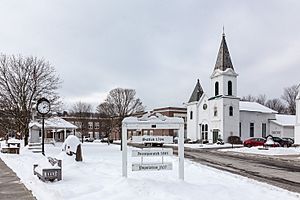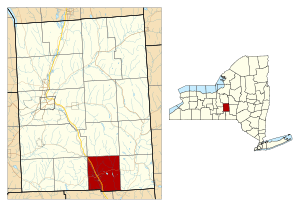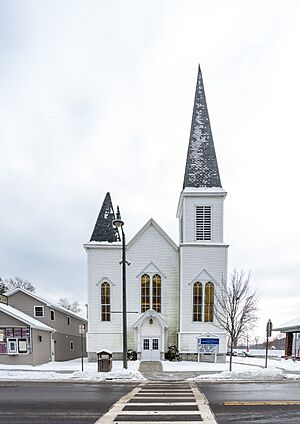Marathon, New York facts for kids
Quick facts for kids
Marathon, New York
|
|
|---|---|
| Town of Marathon | |

Town center in winter
|
|

Location within Cortland County and New York
|
|
| Country | United States |
| State | New York |
| County | Cortland |
| Government | |
| • Type | Town Council |
| Area | |
| • Total | 25.07 sq mi (64.93 km2) |
| • Land | 24.94 sq mi (64.59 km2) |
| • Water | 0.13 sq mi (0.34 km2) |
| Elevation | 1,332 ft (406 m) |
| Population
(2010)
|
|
| • Total | 1,967 |
| • Estimate
(2016)
|
1,888 |
| • Density | 75.71/sq mi (29.23/km2) |
| Time zone | UTC-5 (Eastern (EST)) |
| • Summer (DST) | UTC-4 (EDT) |
| FIPS code | 36-023-45403 |
| GNIS feature ID | 979194 |
Marathon is a small town located in Cortland County, New York, United States. In 2010, about 1,967 people lived there.
The town of Marathon is home to a smaller area called the village of Marathon. This town is found on the southern edge of Cortland County. It is also part of the Southern Tier region of New York State. Marathon is southeast of the city of Cortland.
Every year, Marathon hosts a fun event called the Central New York Maple Festival.
Contents
History of Marathon, New York
Marathon is located in an area that was once part of the Central New York Military Tract. The very first settlers arrived in this area in 1794.
How the Town Got Its Name
The town was first created in 1818. It was formed from a part of the town of Cincinnatus. Back then, it was called the "Town of Harrison."
However, in 1828, the name was changed to "Marathon." This happened because there was already another town in New York named Harrison. The new name, "Marathon," was chosen to honor the famous Battle of Marathon.
Railroad and Village Development
A railroad line, the Delaware, Lackawanna & Western Railroad's Syracuse Branch, opened in Marathon on October 18, 1854. This helped the town grow.
Later, in 1861, the village of Marathon officially separated itself from the larger town. This made it its own incorporated village.
Notable People from Marathon
Marathon has been home to some interesting people:
- Francis G. Brink: He was born in Marathon and became a Brigadier General in the United States Army.
- Carl T. Hayden: He is the only person from New York to have led both the New York State Board of Regents (from 1995 to 2002) and the State University of New York (SUNY) (from 2007 to 2012).
- Thurlow Weed: A well-known political leader and publisher, he moved to Marathon with his family in 1808.
Geography and Landscape of Marathon
The United States Census Bureau says that the town covers a total area of about 64.9 square kilometers (25.07 square miles). Most of this area, about 64.7 square kilometers (24.94 square miles), is land. Only a small part, about 0.3 square kilometers (0.13 square miles), is water.
Major Roads and Rivers
- U.S. Route 11 and Interstate 81 are important highways that run north and south through the town.
- New York State Route 221 is a highway that runs east and west. It crosses U.S. Route 11 in the village of Marathon.
The Tioughnioga River flows through the town. This river is part of the larger Susquehanna River system. It follows a path similar to Interstate 81 and US-11.
The southern border of the town is also the border of Broome County.
Population and Demographics
| Historical population | |||
|---|---|---|---|
| Census | Pop. | %± | |
| 1820 | 807 | — | |
| 1830 | 895 | 10.9% | |
| 1840 | 1,080 | 20.7% | |
| 1850 | 1,341 | 24.2% | |
| 1860 | 1,502 | 12.0% | |
| 1870 | 1,611 | 7.3% | |
| 1880 | 1,700 | 5.5% | |
| 1890 | 1,806 | 6.2% | |
| 1900 | 1,664 | −7.9% | |
| 1910 | 1,589 | −4.5% | |
| 1920 | 1,296 | −18.4% | |
| 1930 | 1,322 | 2.0% | |
| 1940 | 1,417 | 7.2% | |
| 1950 | 1,577 | 11.3% | |
| 1960 | 1,696 | 7.5% | |
| 1970 | 1,777 | 4.8% | |
| 1980 | 1,804 | 1.5% | |
| 1990 | 2,019 | 11.9% | |
| 2000 | 2,189 | 8.4% | |
| 2010 | 1,967 | −10.1% | |
| 2016 (est.) | 1,888 | −4.0% | |
| U.S. Decennial Census | |||
In 2000, the census showed that 2,189 people lived in Marathon. There were 814 households and 598 families. The town had about 87.7 people per square mile.
Diversity and Age Groups
Most of the people in Marathon (98.49%) were White. A smaller number were Black (0.73%) or Native American (0.14%). Some people were from other backgrounds or had mixed heritage. About 0.55% of the population was Hispanic or Latino.
Many households (39.9%) had children under 18 living there. Most families (57.4%) were married couples. About 21.4% of all households were individuals living alone.
The population was spread out by age. About 30.7% were under 18 years old. The median age was 36 years. This means half the people were younger than 36 and half were older.
Income Levels
The average income for a household in the town was $34,274. For families, the average income was $40,379. The average income per person in the town was $15,322.
About 8.6% of families and 10.9% of all people lived below the poverty line. This included 12.3% of those under 18 and 12.0% of those 65 or older.
Communities and Locations in the Town of Marathon
- Dean Pond: This is a small lake located east of the village of Marathon.
- Galatia: A small community, or hamlet, found on the northern border of the town.
- Marathon: This is the main village within the town of Marathon. It is in the western part of the town, close to US-11 and Interstate 81.
- Texas Valley: Another small community, or hamlet, located in the northeastern corner of the town.
Central New York Maple Festival
Marathon hosts an exciting annual festival that celebrates maple products from New York. This event highlights how maple syrup and other maple items are made. It also features many vendors, interesting exhibitions, and live concerts for everyone to enjoy.
See also
 In Spanish: Marathon (Nueva York) para niños
In Spanish: Marathon (Nueva York) para niños




